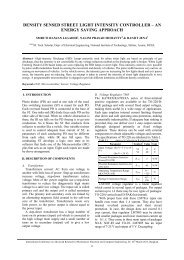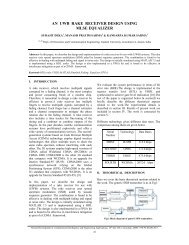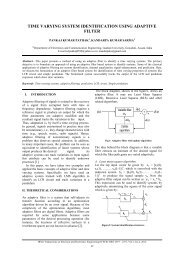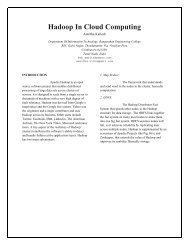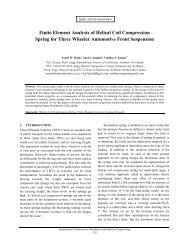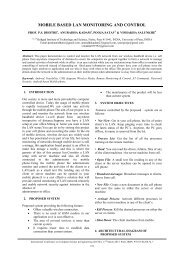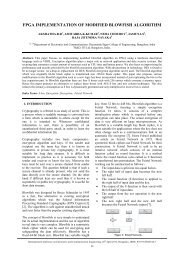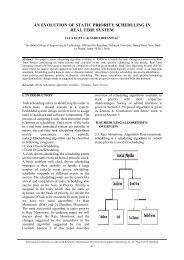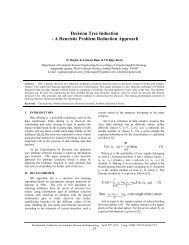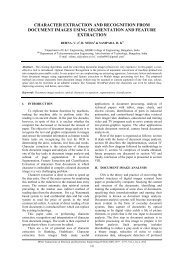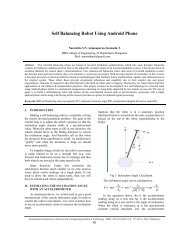CFD Based Performance Analysis of Kaplan Turbine ... - IRNet Explore
CFD Based Performance Analysis of Kaplan Turbine ... - IRNet Explore
CFD Based Performance Analysis of Kaplan Turbine ... - IRNet Explore
Create successful ePaper yourself
Turn your PDF publications into a flip-book with our unique Google optimized e-Paper software.
<strong>CFD</strong> <strong>Based</strong> <strong>Performance</strong> <strong>Analysis</strong> <strong>of</strong> <strong>Kaplan</strong> <strong>Turbine</strong> for Micro Hydro Power<br />
gate opening increases as increasing the runner blade<br />
angle and have maximum efficiency 85.38% at 20°<br />
runner blade angle. The variation <strong>of</strong> efficiency with<br />
runner blade for 65% opening is shown in figure 7.<br />
Runner<br />
Wicket gate<br />
Efficiency<br />
86<br />
85<br />
84<br />
83<br />
82<br />
81<br />
80<br />
79<br />
17 18 19 20 21 22<br />
Runner Blade Angle<br />
Figure 7. Variation <strong>of</strong> efficiency with runner blade angle<br />
Tubular casing with daft tube<br />
Figure 5. Contours <strong>of</strong> components <strong>of</strong> <strong>Kaplan</strong> turbine for<br />
design condition<br />
3.3 Efficiency at 75% wicket gate opening<br />
Four different runner blade angles17°, 18°, 19° and 20°<br />
has been used for four simulation <strong>of</strong> the <strong>Kaplan</strong> at 75%<br />
<strong>of</strong> wicket gate opening. The efficiency for 75% wicket<br />
gate opening increases as increasing the runner blade<br />
angle and have maximum efficiency 90.41% at 19°<br />
runner blade angle. The variation <strong>of</strong> efficiency with<br />
runner blade is shown in figure 6.<br />
Efficiency<br />
91<br />
90<br />
89<br />
88<br />
87<br />
86<br />
85<br />
84<br />
16 17 18 19 20 21<br />
Runner Blade angle<br />
Figure 6. Variation <strong>of</strong> efficiency with runner blade angle<br />
3.4 Efficiency at 65% wicket gate opening<br />
Four different runner blade angles18°, 19°, 20° and 21°<br />
has been used for four simulation <strong>of</strong> the <strong>Kaplan</strong> at 65%<br />
<strong>of</strong> wicket gate opening. The efficiency for 65% wicket<br />
3.5 Efficiency at 55% wicket gate opening<br />
Four different runner blade angles19°, 20°, 21° and 22°<br />
has been used for four simulation <strong>of</strong> the <strong>Kaplan</strong> at 55%<br />
<strong>of</strong> wicket gate opening. The efficiency for 55% wicket<br />
gate opening increases as increasing the runner blade<br />
angle and have maximum efficiency 76.35% at 21°<br />
runner blade angle. The variation <strong>of</strong> efficiency with<br />
runner blade is shown in figure 8.<br />
Efficiency<br />
77<br />
76<br />
75<br />
74<br />
73<br />
72<br />
71<br />
70<br />
18 19 20 21 22 23<br />
Runner Blade Angle<br />
Figure 8. Variation <strong>of</strong> efficiency with runner blade angle<br />
3.6 Efficiency curve for different operating conditions<br />
The graph between efficiency and runner blade angle are<br />
show in figure 9. The figure shows different wicket gate<br />
opening curves which is shown by different colors. The<br />
efficiency curve plot by joining efficiency <strong>of</strong> design<br />
condition and the peak efficiencies <strong>of</strong> all part load<br />
conditions.<br />
International Conference on Mechanical and Industrial Engineering<br />
12





